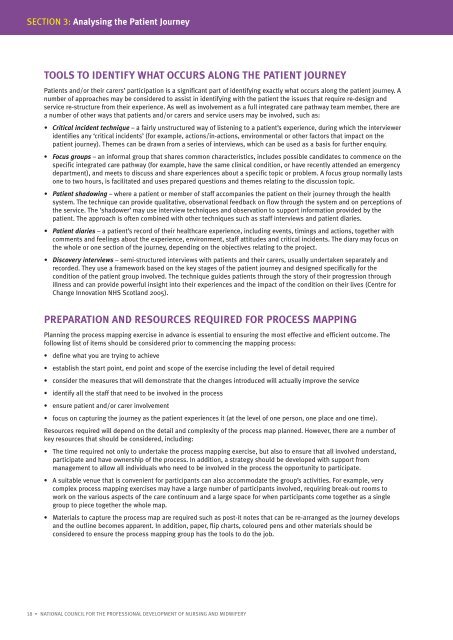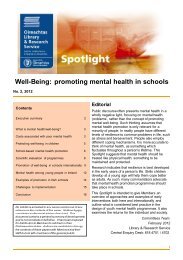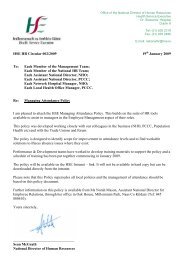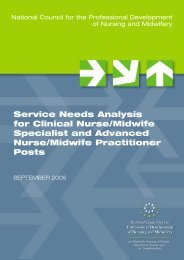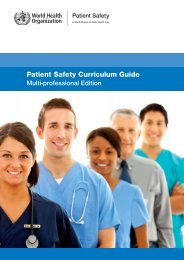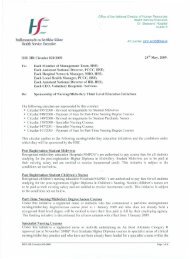Integrated Care Pathways - PNA
Integrated Care Pathways - PNA
Integrated Care Pathways - PNA
- No tags were found...
You also want an ePaper? Increase the reach of your titles
YUMPU automatically turns print PDFs into web optimized ePapers that Google loves.
SECTION 3: Analysing the Patient JourneyTOOLS TO IDENTIFY WHAT OCCURS ALONG THE PATIENT JOURNEYPatients and/or their carers’ participation is a significant part of identifying exactly what occurs along the patient journey. Anumber of approaches may be considered to assist in identifying with the patient the issues that require re-design andservice re-structure from their experience. As well as involvement as a full integrated care pathway team member, there area number of other ways that patients and/or carers and service users may be involved, such as:• Critical incident technique – a fairly unstructured way of listening to a patient’s experience, during which the intervieweridentifies any ‘critical incidents’ (for example, actions/in-actions, environmental or other factors that impact on thepatient journey). Themes can be drawn from a series of interviews, which can be used as a basis for further enquiry.• Focus groups – an informal group that shares common characteristics, includes possible candidates to commence on thespecific integrated care pathway (for example, have the same clinical condition, or have recently attended an emergencydepartment), and meets to discuss and share experiences about a specific topic or problem. A focus group normally lastsone to two hours, is facilitated and uses prepared questions and themes relating to the discussion topic.• Patient shadowing – where a patient or member of staff accompanies the patient on their journey through the healthsystem. The technique can provide qualitative, observational feedback on flow through the system and on perceptions ofthe service. The ‘shadower’ may use interview techniques and observation to support information provided by thepatient. The approach is often combined with other techniques such as staff interviews and patient diaries.• Patient diaries – a patient’s record of their healthcare experience, including events, timings and actions, together withcomments and feelings about the experience, environment, staff attitudes and critical incidents. The diary may focus onthe whole or one section of the journey, depending on the objectives relating to the project.• Discovery interviews – semi-structured interviews with patients and their carers, usually undertaken separately andrecorded. They use a framework based on the key stages of the patient journey and designed specifically for thecondition of the patient group involved. The technique guides patients through the story of their progression throughillness and can provide powerful insight into their experiences and the impact of the condition on their lives (Centre forChange Innovation NHS Scotland 2005).PREPARATION AND RESOURCES REQUIRED FOR PROCESS MAPPINGPlanning the process mapping exercise in advance is essential to ensuring the most effective and efficient outcome. Thefollowing list of items should be considered prior to commencing the mapping process:• define what you are trying to achieve• establish the start point, end point and scope of the exercise including the level of detail required• consider the measures that will demonstrate that the changes introduced will actually improve the service• identify all the staff that need to be involved in the process• ensure patient and/or carer involvement• focus on capturing the journey as the patient experiences it (at the level of one person, one place and one time).Resources required will depend on the detail and complexity of the process map planned. However, there are a number ofkey resources that should be considered, including:• The time required not only to undertake the process mapping exercise, but also to ensure that all involved understand,participate and have ownership of the process. In addition, a strategy should be developed with support frommanagement to allow all individuals who need to be involved in the process the opportunity to participate.• A suitable venue that is convenient for participants can also accommodate the group’s activities. For example, verycomplex process mapping exercises may have a large number of participants involved, requiring break-out rooms towork on the various aspects of the care continuum and a large space for when participants come together as a singlegroup to piece together the whole map.• Materials to capture the process map are required such as post-it notes that can be re-arranged as the journey developsand the outline becomes apparent. In addition, paper, flip charts, coloured pens and other materials should beconsidered to ensure the process mapping group has the tools to do the job.18 • NATIONAL COUNCIL FOR THE PROFESSIONAL DEVELOPMENT OF NURSING AND MIDWIFERY


